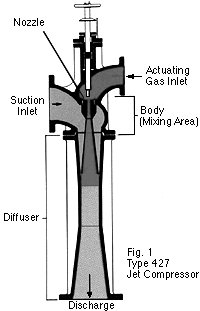Thermocompressors
 Thermocompressors, or jet gas compressors, utilize a high pressure gas to entrain a low pressure gas and discharge the pressure to an intermediate pressure. These types of compressors have three main parts - a nozzle, body and diffuser. The design of the nozzle follows thermodynamic laws. Design of the diffuser is partially empirical. For this reason, S&K's long experience in designing, manufacturing and testing jet compressors is extremely beneficial.
Thermocompressors, or jet gas compressors, utilize a high pressure gas to entrain a low pressure gas and discharge the pressure to an intermediate pressure. These types of compressors have three main parts - a nozzle, body and diffuser. The design of the nozzle follows thermodynamic laws. Design of the diffuser is partially empirical. For this reason, S&K's long experience in designing, manufacturing and testing jet compressors is extremely beneficial.
Theory
The motive gas, under pressure, enters the compressors and flows through the nozzle. The nozzle converts the high pressure gas into a high velocity jet stream which creates a suction and causes the entrainment of the low pressure gas. The motive and suction gas are mixed in the body. The diffuser then converts the velocity head of the gas mixture to a static head so that proper discharge pressure can be obtained.
Jet gas compressors can be divided into two categories based upon the type of performance.
- 1. Non-critical Compressors refers to units whose absolute pressure at the compressor discharge is less than 1.8 times the absolute pressure at the suctions. When the performance is noncritical, a constant pressure can be maintained at the suction of the compressor, at varying capacities, by controlling the motive flow. These types of units can be furnished with a spindle that can be controlled either manually or automatically.
2. Critical Compressors refers to units whose absolute pressure at the discharge is equal to or greater than 1.8 times the absolute pressure of the suction. When performance is critical, control cannot be exerted by means of the motive fluid. In order to control the suction pressure of such a unit at varying process loads, it is necessary to maintain a constant load on the compressors by addition of a secondary suction fluid, or to vary the suction pressure at the compressor by introducing an artificial pressure drop in the suction line.
Schutte & Koerting, 2233 State Road, Bensalem, PA 19020. Tel: 215-639-0900; Fax: 215-639-1597.
